Welcome to a genuinely enchanting voyage as we invite you to discover the diverse and captivating realm of Japan’s Most Beautiful Gardens on sakurachronicles.com. In this comprehensive blog post, we will guide you through a tapestry of breathtaking natural wonders, ranging from the timeless elegance of traditional Japanese gardens to the modern, vibrant city parks that dot this mesmerizing landscape.
Japan’s gardens and parks have captivated visitors for centuries with their breathtaking beauty. These serene spaces embody the art of landscape design, seamlessly blending artificial elements with the tranquility of nature. Experience the perfect harmony of design and nature in Japan’s exquisite gardens and parks. This blog post is your passport to explore these natural gems, each a testament to the meticulous craftsmanship and deep reverence for the natural world that characterizes Japanese culture.
Our journey will take us through a curated selection of these horticultural masterpieces, revealing the hidden treasures every visitor should not miss. From the serene, moss-covered stones of ancient Kyoto temples to the vibrant and contemporary urban parks of Tokyo, we’ll delve into the heart of each garden’s unique character, history, and seasonal splendors.
Join us as we embark on this odyssey, exploring the gardens that offer a peaceful respite, an opportunity to connect with nature, and an immersion into the rich tapestry of Japanese horticultural heritage. Let’s step into a world where every stone, every tree, and every carefully placed element tells a story, where the seasons paint a vivid backdrop, and where tranquility and beauty reign supreme.
Below we have a little summary of our post.
| Location | Key Takeaway |
|---|---|
| Shinjuku Gyoen National Garden, Tokyo | – Divided into three sections: a traditional Japanese garden, a French garden, and an English landscape garden. – Popular for cherry blossom viewing and picnics. – Provides an escape from the bustling city of Tokyo. – Offers a peaceful setting with walking paths. – The greenhouse features tropical plants and flowers. |
| Rikugien Garden, Tokyo | – A beautiful traditional Japanese garden built during the Edo period. – Features a central pond surrounded by trees, rocks, and hills. – Stunning during the autumn foliage season. |
| Kairakuen Garden, Mito | – One of the Three Great Gardens of Japan. – Famous for its plum blossom season in February and March, with over 3,000 plum trees. – A must-visit for garden enthusiasts. |
| Tsuruga Castle Park, Aizu-Wakamatsu | – Located in Fukushima, home to Tsuruga Castle’s ruins and cherry trees. – The park includes a large pond and a waterfall, offering a historical and natural experience. |
| Adachi Museum of Art, Shimane | – Known for its stunning gardens designed to be viewed from inside the museum. – Features traditional Japanese garden elements like rocks, water, and plants. – Houses a collection of modern Japanese art. |
| Okayama Korakuen Garden, Okayama | – Another of Japan’s Three Great Gardens, famous for its late February and early March plum blossom season. – An Edo period garden with historical significance. |
| Hama Rikyu Gardens, Tokyo | – A traditional Japanese garden located on the Sumida River’s banks. – Known for autumn foliage and spring cherry blossoms. – Features a large central pond and a teahouse. |
| Hitachi Seaside Park, Ibaraki | – A large park with diverse flowers and trees, including daffodils, tulips, and baby blue eyes flowers. – Offers a vibrant floral experience north of Tokyo. |
| Kenrokuen Garden, Ishikawa Prefecture | – One of Japan’s most famous gardens, over 300 years old. – Features a large pond, tea houses, bridges, and traditional Japanese landscaping. – Spectacular during cherry blossom and autumn leaves seasons. |
| Ritsurin Garden, Kagawa Prefecture | – Over 400 years old, considered one of Japan’s most beautiful gardens. – Traditional Japanese landscaping, a large pond, and scenic walking paths. – Ideal for cherry blossom viewing and picnics. |
| Tofukuji Temple, Kyoto | – Best known for its red and yellow fall foliage, a stunning spot during autumn. – One of Kyoto’s oldest and largest temples, offering cultural and natural beauty. |
| Shukkeien Garden, Hiroshima | – Built in the 17th century with miniature landscapes resembling famous natural scenes. – Lovely during cherry blossom and autumn foliage seasons, showcasing Japanese garden artistry. |
Here Are Our Top Picks On Japan’s Most Beautiful Gardens
Shinjuku Gyoen National Garden – Tokyo
Shinjuku Gyoen National Garden is one of the largest parks in Tokyo and is a popular spot for cherry blossom viewing and picnics. The garden is divided into three sections: a traditional Japanese garden, a French garden, and an English landscape garden. The park also features a greenhouse and numerous walking paths. It’s a great place to escape the hustle and bustle of Tokyo for a peaceful afternoon.
The park is so large that it’s easy to find a quiet spot to relax and enjoy the scenery. Be sure also to check out the greenhouse, which features tropical plants and flowers.

Rikugien Garden (Tokyo)
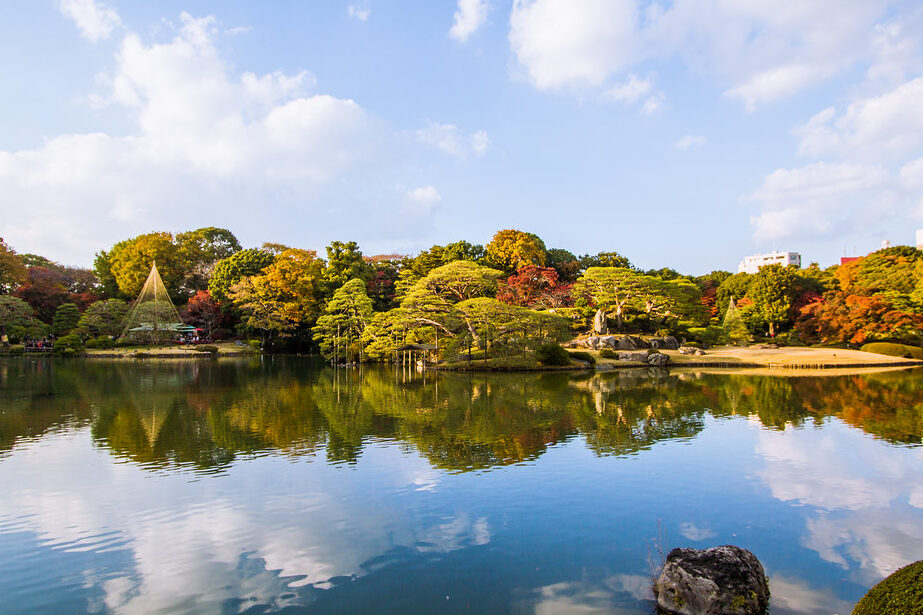
Rikugien Garden is another beautiful traditional Japanese garden located in Tokyo. It was built during the Edo period and featured a large central pond surrounded by trees, rocks, and small hills. The garden is lovely during the autumn foliage season, when the trees turn vibrant shades of red and gold.

Kairakuen Garden (Mito) Is One Of Out Top Pick For Japan’s Most Beautiful Gardens
Kairakuen Garden is another one of the Three Great Gardens of Japan. It is located in Mito and is particularly famous for its plum blossom season, which takes place in February and March. The garden is home to over 3,000 plum trees, as well as a variety of other trees and flowers. If you do not have too much free time during your trip, this is one of Japan’s Most Beautiful Gardens you should consider visiting!
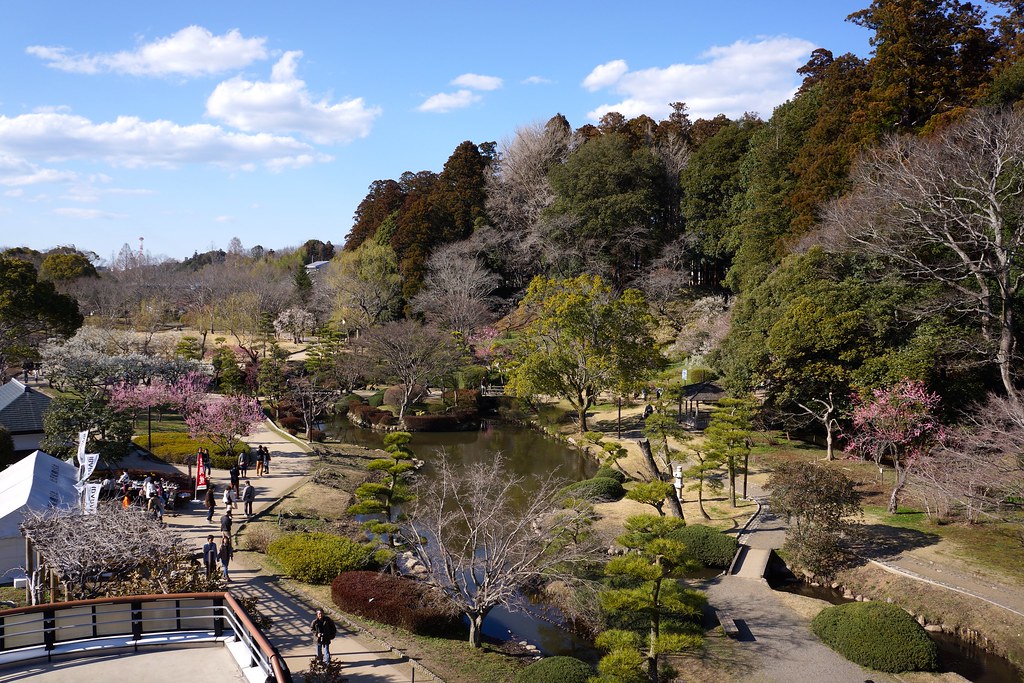
Tsuruga Castle Park (Aizu-Wakamatsu)
Tsuruga Castle Park is located in Aizu-Wakamatsu, in the Fukushima prefecture. The park is home to Tsuruga Castle’s ruins, destroyed during the Boshin War in the late 19th century. The park features a variety of cherry trees, as well as a large pond and a waterfall.
Adachi Museum of Art (Shimane)
While not strictly a garden or park, the Adachi Museum of Art is known for its stunning gardens surrounding the building. The gardens were designed to be viewed from inside the museum and feature a variety of traditional Japanese garden elements such as rocks, water, and plants. The museum itself houses a collection of modern Japanese art.
Okayama Korakuen Garden (Okayama)
Okayama Korakuen is another one of the Three Great Gardens of Japan, and it is located in Okayama and was built during the Edo period. The garden is particularly famous for its plum blossom season, which takes place in late February and early March.
Hama Rikyu Gardens (Tokyo)
Hama Rikyu Gardens is a traditional Japanese garden in Tokyo’s heart. It is located on the banks of the Sumida River and features a large central pond, a teahouse, and a variety of trees and flowers. The garden is particularly famous for its autumn foliage and spring cherry blossoms.
For Flower Lovers Hitachi Seaside Park (Ibaraki) Is One Of Japan’s Most Beautiful Gardens

Hitachi Seaside Park is a large Ibaraki prefecture park just north of Tokyo. The park is home to various flowers and trees, including 4.5 million daffodils, 170 types of tulips, and a large field of baby blue eyes flowers.
Kenrokuen Garden – In Ishikawa Prefecture Is One Of Japan’s Most Beautiful Gardens
Kenrokuen Garden is one of the most famous gardens in Japan and is located in Kanazawa City, Ishikawa Prefecture. The garden is over 300 years old and is considered one of Japan’s three most beautiful landscape gardens. The name “Kenrokuen” means “garden of six attributes,” which refers to the qualities that make up the ideal garden in Chinese culture: spaciousness, seclusion, artifice, antiquity, watercourses, and panoramas.
The garden features a large pond, tea houses, bridges, and traditional Japanese landscaping. The cherry blossom and autumn leaves seasons are beautiful times to visit.
The vibrant colors of the autumn leaves mixed with the garden’s layout left me awestruck during my visit. Visitors should also explore the nearby Kanazawa Castle Park for more stunning views.
Ritsurin Garden – Kagawa Prefecture
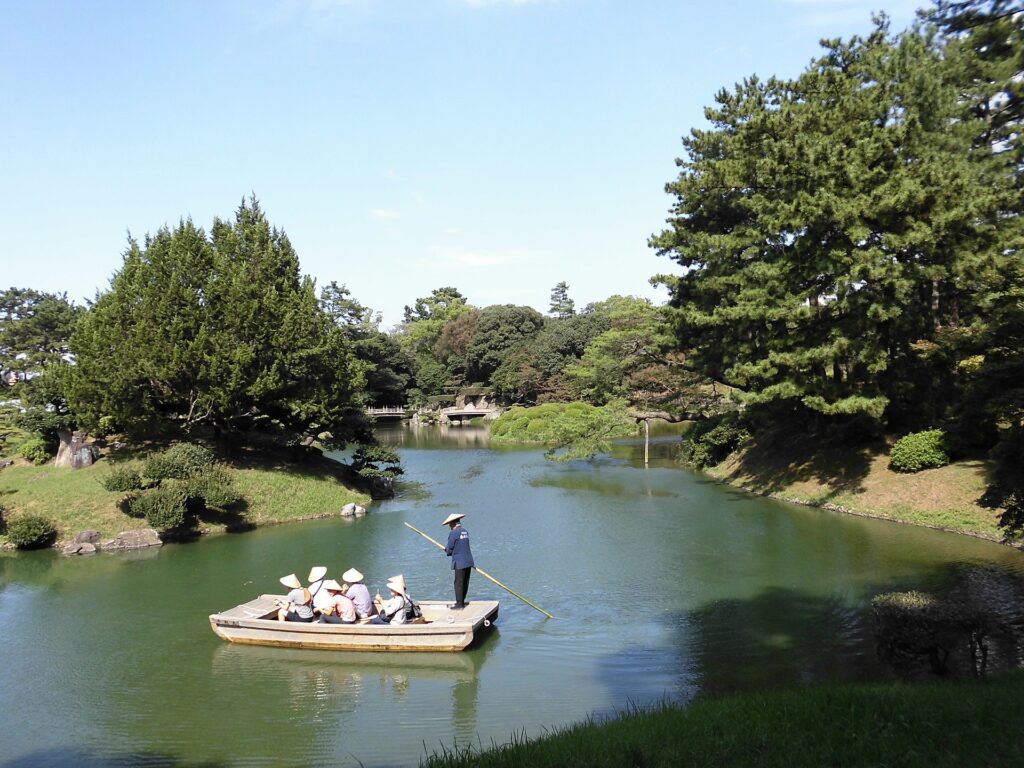
Ritsurin Garden is a stunning park located in Takamatsu City, Kagawa Prefecture. The garden is over 400 years old and is considered one of Japan’s most beautiful. The park features traditional Japanese landscaping, a large pond, and numerous walking paths. It’s a popular spot for cherry blossom viewing and picnics.
Tokufuji Temple
If you are in Kyoto during the fall, you will want to experience the beautiful colors of the foliage in the Tofukuji Temple. The garden is famous for its red and yellow leaves, and it’s considered one of the best spots to see fall foliage in Japan. The temple is also worth a visit, as it’s one of the oldest and largest in Kyoto.
Shukkeien Garden
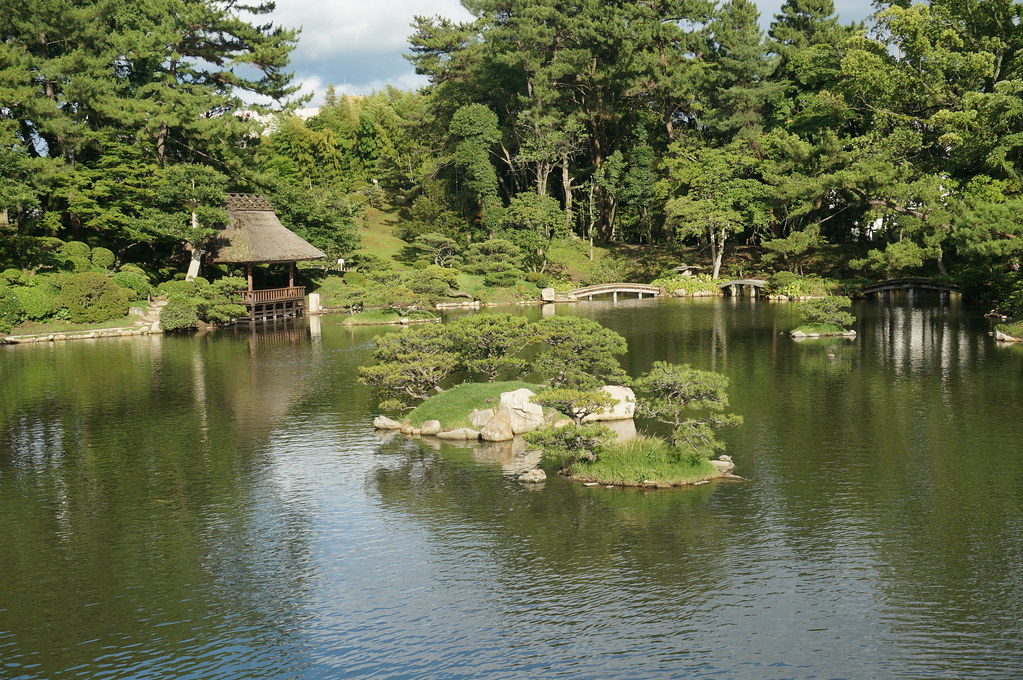
In Hiroshima, you can visit the Shukkeien Garden, which means “shrunken-scenery garden.” The garden was built in the 17th century and featured miniature landscapes that resemble famous natural scenes from around Japan. The garden is lovely during the cherry blossom and autumn foliage seasons.
How to get there
| Location | How to get there from Tokyo | How to get there from Osaka | How to get there from Nagoya |
|---|---|---|---|
| Shinjuku Gyoen National Garden, Tokyo | – By train: The park is a 10-minute walk from Shinjuku Station or a 5-minute walk from Shinjukugyoenmae Station on the Marunouchi Subway Line. – By bus: Several bus lines stop near the park, including the 97 Shinagawa-Shinjuku line. – By car: There is no parking available at the park, so it is not recommended to drive there. | – By air: The nearest airport is Tokyo Haneda International Airport, which is about 14.7 km away from the park. You can take a bus, train, or taxi from the airport to Shinjuku Station or Shinjukugyoenmae Station. – By train: You can take the Tokaido Shinkansen from Shin-Osaka Station to Tokyo Station, which takes about 2.5 hours and costs around 14,000 yen. Then you can transfer to the JR Yamanote Line or the Marunouchi Subway Line to get to the park. – By bus: You can take a highway bus from Osaka Station or Umeda Station to Shinjuku Station, which takes about 8-9 hours and costs around 4,000-8,000 yen. Then you can walk or take the subway to the park. | – By air: The nearest airport is Tokyo Haneda International Airport, which is about 14.7 km away from the park. You can take a bus, train, or taxi from the airport to Shinjuku Station or Shinjukugyoenmae Station. – By train: You can take the Tokaido Shinkansen from Nagoya Station to Tokyo Station, which takes about 1.5 hours and costs around 10,000 yen. Then you can transfer to the JR Yamanote Line or the Marunouchi Subway Line to get to the park. – By bus: You can take a highway bus from Nagoya Station or Meitetsu Bus Center to Shinjuku Station, which takes about 6-7 hours and costs around 3,000-6,000 yen. Then you can walk or take the subway to the park. |
| Rikugien Garden, Tokyo | – By train: The park is a 5-10 minute walk south of Komagome Station on the JR Yamanote Line or Namboku Subway Line. – By bus: Several bus lines stop near the park, including the 97 Shinagawa-Shinjuku line. – By car: There is no parking available at the park, so it is not recommended to drive there. | – By air: The nearest airport is Tokyo Haneda International Airport, which is about 57 km away from the park. You can take a bus, train, or taxi from the airport to Komagome Station. – By train: You can take the Tokaido Shinkansen from Shin-Osaka Station to Tokyo Station, which takes about 2.5 hours and costs around 14,000 yen. Then you can transfer to the JR Yamanote Line or the Namboku Subway Line to get to the park. – By bus: You can take a highway bus from Osaka Station or Umeda Station to Tokyo Station, which takes about 8-9 hours and costs around 4,000-8,000 yen. Then you can transfer to the JR Yamanote Line or the Namboku Subway Line to get to the park. | – By air: The nearest airport is Tokyo Haneda International Airport, which is about 57 km away from the park. You can take a bus, train, or taxi from the airport to Komagome Station. – By train: You can take the Tokaido Shinkansen from Nagoya Station to Tokyo Station, which takes about 1.5 hours and costs around 10,000 yen. Then you can transfer to the JR Yamanote Line or the Namboku Subway Line to get to the park. – By bus: You can take a highway bus from Nagoya Station or Meitetsu Bus Center to Tokyo Station, which takes about 6-7 hours and costs around 3,000-6,000 yen. Then you can transfer to the JR Yamanote Line or the Namboku Subway Line to get to the park. |
| Kairakuen Garden, Mito | – By train: The park is a 15-minute bus ride from JR Mito Station on the Joban Line, which is about 1.5 hours from Tokyo Station. – By bus: There is a direct bus from Tokyo Station to Kairakuen Garden, which takes about 2 hours and costs around 2,000 yen. – By car: The park is about 100 km from Tokyo and can be reached via the Joban Expressway. | – By air: The nearest airport is Ibaraki Airport, which is about 40 km from the park. You can take a bus or taxi from the airport to Mito Station or Kairakuen Garden. – By train: You can take the Tokaido Shinkansen from Shin-Osaka Station to Tokyo Station, which takes about 2.5 hours and costs around 14,000 yen. Then you can transfer to the Joban Line to get to Mito Station and take a bus to the park. – By bus: You can take a highway bus from Osaka Station or Umeda Station to Tokyo Station, which takes about 8-9 hours and costs around 4,000-8,000 yen. Then you can transfer to the Joban Line to get to Mito Station and take a bus to the park. | – By air: The nearest airport is Ibaraki Airport, which is about 40 km from the park. You can take a bus or taxi from the airport to Mito Station or Kairakuen Garden. – By train: You can take the Tokaido Shinkansen from Nagoya Station to Tokyo Station, which takes about 1.5 hours and costs around 10,000 yen. Then you can transfer to the Joban Line to get to Mito Station and take a bus to the park. – By bus: You can take a highway bus from Nagoya Station or Meitetsu Bus Center to Tokyo Station, which takes about 6-7 hours and costs around 3,000-6,000 yen. Then you can transfer to the Joban Line to get to Mito Station and take a bus to the park. |
| Destination | Tokyo | Osaka | Nagoya |
|---|---|---|---|
| Tsuruga Castle Park, Aizu-Wakamatsu | – By air: Fly from Haneda Airport to Fukushima Airport (1 hour), then take a bus to Koriyama Station (40 minutes) and a train to Aizu-Wakamatsu Station (70 minutes). – By car: Drive from Tokyo to Aizu-Wakamatsu via Tohoku Expressway and Ban-etsu Expressway (about 4 hours). – By public transportation: Take the JR Tohoku Shinkansen from Tokyo Station to Koriyama Station (80 minutes), then transfer to the JR Ban-etsu West Line to Aizu-Wakamatsu Station (70 minutes). | – By air: Fly from Itami Airport or Kansai Airport to Fukushima Airport (1.5 hours), then take a bus to Koriyama Station (40 minutes) and a train to Aizu-Wakamatsu Station (70 minutes). – By car: Drive from Osaka to Aizu-Wakamatsu via Meishin Expressway, Hokuriku Expressway, and Ban-etsu Expressway (about 7 hours). – By public transportation: Take the JR Tokaido Shinkansen from Shin-Osaka Station to Tokyo Station (2.5 hours), then transfer to the JR Tohoku Shinkansen to Koriyama Station (80 minutes) and the JR Ban-etsu West Line to Aizu-Wakamatsu Station (70 minutes). | – By air: Fly from Chubu Centrair International Airport to Fukushima Airport (1 hour), then take a bus to Koriyama Station (40 minutes) and a train to Aizu-Wakamatsu Station (70 minutes). – By car: Drive from Nagoya to Aizu-Wakamatsu via Tomei Expressway, Kan-etsu Expressway, and Ban-etsu Expressway (about 6 hours). – By public transportation: Take the JR Tokaido Shinkansen from Nagoya Station to Tokyo Station (2 hours), then transfer to the JR Tohoku Shinkansen to Koriyama Station (80 minutes) and the JR Ban-etsu West Line to Aizu-Wakamatsu Station (70 minutes). |
| Adachi Museum of Art, Shimane | – By air: Fly from Haneda Airport or Narita Airport to Yonago Airport (1.5 hours), then take a bus to Yasugi Station (30 minutes) and a free shuttle bus to the museum (20 minutes). – By car: Drive from Tokyo to Yasugi via Tohoku Expressway, Kan-etsu Expressway, Hokuriku Expressway, and Yonago Expressway (about 10 hours). – By public transportation: Take the JR Tokaido Shinkansen from Tokyo Station to Okayama Station (4 hours), then transfer to the JR Yakumo limited express train to Yonago Station (2.5 hours) and a local train to Yasugi Station (15 minutes). From there, take a free shuttle bus to the museum (20 minutes). | – By air: Fly from Itami Airport or Kansai Airport to Yonago Airport (1 hour), then take a bus to Yasugi Station (30 minutes) and a free shuttle bus to the museum (20 minutes). – By car: Drive from Osaka to Yasugi via Chugoku Expressway, Yonago Expressway, and Matsue Expressway (about 4 hours). – By public transportation: Take the JR Tokaido Shinkansen from Shin-Osaka Station to Okayama Station (45 minutes), then transfer to the JR Yakumo limited express train to Yonago Station (2.5 hours) and a local train to Yasugi Station (15 minutes). From there, take a free shuttle bus to the museum (20 minutes). | – By air: Fly from Chubu Centrair International Airport or Komaki Airport to Yonago Airport (1 hour), then take a bus to Yasugi Station (30 minutes) and a free shuttle bus to the museum (20 minutes). – By car: Drive from Nagoya to Yasugi via Meishin Expressway, Chugoku Expressway, Yonago Expressway, and Matsue Expressway (about 6 hours). – By public transportation: Take the JR Tokaido Shinkansen from Nagoya Station to Okayama Station (2 hours), then transfer to the JR Yakumo limited express train to Yonago Station (2.5 hours) and a local train to Yasugi Station (15 minutes). From there, take a free shuttle bus to the museum (20 minutes). |
| Okayama Korakuen Garden, Okayama | – By air: Fly from Haneda Airport or Narita Airport to Okayama Airport (1.5 hours), then take a bus to Okayama Station (30 minutes) and another bus to the garden’s main gate (10 minutes). – By car: Drive from Tokyo to Okayama via Tomei Expressway, Meishin Expressway, and Sanyo Expressway (about 9 hours). – By public transportation: Take the JR Tokaido Shinkansen from Tokyo Station to Okayama Station (4 hours), then take a bus to the garden’s main gate (10 minutes) or a tram to Shiroshita stop (5 minutes) and walk to the garden’s south gate (10 minutes). | – By air: Fly from Itami Airport or Kansai Airport to Okayama Airport (1 hour), then take a bus to Okayama Station (30 minutes) and another bus to the garden’s main gate (10 minutes). – By car: Drive from Osaka to Okayama via Chugoku Expressway and Sanyo Expressway (about 3 hours). – By public transportation: Take the JR Tokaido Shinkansen from Shin-Osaka Station to Okayama Station (45 minutes), then take a bus to the garden’s main gate (10 minutes) or a tram to Shiroshita stop (5 minutes) and walk to the garden’s south gate (10 minutes). | – By air: Fly from Chubu Centrair International Airport or Komaki Airport to Okayama Airport (1 hour), then take a bus to Okayama Station (30 minutes) and another bus to the garden’s main gate (10 minutes). – By car: Drive from Nagoya to Okayama via Meishin Expressway and Sanyo Expressway (about 5 hours). – By public transportation: Take the JR Tokaido Shinkansen from Nagoya Station to Okayama Station (2 hours), then take a bus to the garden’s main gate (10 minutes) or a tram to Shiroshita stop (5 minutes) and walk to the garden’s south gate (10 minutes). |
| Destination | Tokyo | Osaka | Nagoya |
|---|---|---|---|
| Hama Rikyu Gardens, Tokyo | – By public transportation: Take the JR Yamanote Line, Keihin-Tohoku Line or Tokyo Metro Ginza Line to Shimbashi Station, then walk for 10 minutes or take the Yurikamome Line to Shiodome Station and walk for 5 minutes. – By car: Drive from central Tokyo to Shiodome via the Metropolitan Expressway Inner Circular Route (about 20 minutes). | – By air: Fly from Itami Airport or Kansai Airport to Haneda Airport (1 hour), then take the Tokyo Monorail to Hamamatsucho Station and walk for 15 minutes or take the Yurikamome Line to Shiodome Station and walk for 5 minutes. – By car: Drive from Osaka to Tokyo via Meishin Expressway, Tomei Expressway, and Metropolitan Expressway Inner Circular Route (about 7 hours). – By public transportation: Take the JR Tokaido Shinkansen from Shin-Osaka Station to Tokyo Station (2.5 hours), then transfer to the JR Yamanote Line, Keihin-Tohoku Line or Tokyo Metro Ginza Line to Shimbashi Station and walk for 10 minutes or take the Yurikamome Line to Shiodome Station and walk for 5 minutes. | – By air: Fly from Chubu Centrair International Airport or Komaki Airport to Haneda Airport (1 hour), then take the Tokyo Monorail to Hamamatsucho Station and walk for 15 minutes or take the Yurikamome Line to Shiodome Station and walk for 5 minutes. – By car: Drive from Nagoya to Tokyo via Tomei Expressway and Metropolitan Expressway Inner Circular Route (about 6 hours). – By public transportation: Take the JR Tokaido Shinkansen from Nagoya Station to Tokyo Station (2 hours), then transfer to the JR Yamanote Line, Keihin-Tohoku Line or Tokyo Metro Ginza Line to Shimbashi Station and walk for 10 minutes or take the Yurikamome Line to Shiodome Station and walk for 5 minutes. |
| Hitachi Seaside Park, Ibaraki | – By public transportation: Take the JR Joban Line from Ueno Station to Katsuta Station (80 minutes), then take a bus to Hitachi Seaside Park West Gate or South Gate (15-20 minutes). – By car: Drive from Tokyo to Hitachi Seaside Park via Joban Expressway and Hitachi Seaside Park Interchange (about 2 hours). | – By air: Fly from Itami Airport or Kansai Airport to Narita Airport (1.5 hours), then take a bus to Hitachi Seaside Park West Gate or South Gate (2.5 hours). – By car: Drive from Osaka to Hitachi Seaside Park via Meishin Expressway, Tomei Expressway, Joban Expressway, and Hitachi Seaside Park Interchange (about 8 hours). – By public transportation: Take the JR Tokaido Shinkansen from Shin-Osaka Station to Tokyo Station (2.5 hours), then transfer to the JR Joban Line to Katsuta Station (80 minutes) and take a bus to Hitachi Seaside Park West Gate or South Gate (15-20 minutes). | – By air: Fly from Chubu Centrair International Airport or Komaki Airport to Narita Airport (1 hour), then take a bus to Hitachi Seaside Park West Gate or South Gate (2.5 hours). – By car: Drive from Nagoya to Hitachi Seaside Park via Tomei Expressway, Joban Expressway, and Hitachi Seaside Park Interchange (about 6 hours). – By public transportation: Take the JR Tokaido Shinkansen from Nagoya Station to Tokyo Station (2 hours), then transfer to the JR Joban Line to Katsuta Station (80 minutes) and take a bus to Hitachi Seaside Park West Gate or South Gate (15-20 minutes). |
| Kenrokuen Garden, Ishikawa Prefecture | – By air: Fly from Haneda Airport or Narita Airport to Komatsu Airport (1 hour), then take a bus to Kanazawa Station (40 minutes) and another bus or taxi to Kenrokuen Garden (10-15 minutes). – By car: Drive from Tokyo to Kanazawa via Kan-etsu Expressway, Hokuriku Expressway, and Kanazawa Morimoto Interchange (about 6 hours). – By public transportation: Take the JR Hokuriku Shinkansen from Tokyo Station to Kanazawa Station (2.5 hours), then take a bus or taxi to Kenrokuen Garden (10-15 minutes). | – By air: Fly from Itami Airport or Kansai Airport to Komatsu Airport (1 hour), then take a bus to Kanazawa Station (40 minutes) and another bus or taxi to Kenrokuen Garden (10-15 minutes). – By car: Drive from Osaka to Kanazawa via Meishin Expressway, Hokuriku Expressway, and Kanazawa Morimoto Interchange (about 4 hours). – By public transportation: Take the JR Thunderbird limited express train from Shin-Osaka Station to Kanazawa Station (2.5 hours), then take a bus or taxi to Kenrokuen Garden (10-15 minutes). | – By air: Fly from Chubu Centrair International Airport or Komaki Airport to Komatsu Airport (1 hour), then take a bus to Kanazawa Station (40 minutes) and another bus or taxi to Kenrokuen Garden (10-15 minutes). – By car: Drive from Nagoya to Kanazawa via Meishin Expressway, Hokuriku Expressway, and Kanazawa Morimoto Interchange (about 3 hours). – By public transportation: Take the JR Shirasagi limited express train from Nagoya Station to Kanazawa Station (2.5 hours), then take a bus or taxi to Kenrokuen Garden (10-15 minutes). |
| Destination | Tokyo | Osaka | Nagoya |
|---|---|---|---|
| Ritsurin Garden, Kagawa Prefecture | – By air: Fly from Haneda Airport or Narita Airport to Takamatsu Airport (1.5 hours), then take a bus to Kawaramachi Station (40 minutes) and a tram to Ritsurin-koen-mae Station (10 minutes). – By car: Drive from Tokyo to Takamatsu via Tomei Expressway, Meishin Expressway, Sanyo Expressway, and Takamatsu Expressway (about 10 hours). – By public transportation: Take the JR Tokaido Shinkansen from Tokyo Station to Okayama Station (4 hours), then transfer to the JR Marine Liner to Takamatsu Station (1 hour) and a tram to Ritsurin-koen-mae Station (15 minutes). | – By air: Fly from Itami Airport or Kansai Airport to Takamatsu Airport (1 hour), then take a bus to Kawaramachi Station (40 minutes) and a tram to Ritsurin-koen-mae Station (10 minutes). – By car: Drive from Osaka to Takamatsu via Chugoku Expressway, Sanyo Expressway, and Takamatsu Expressway (about 4 hours). – By public transportation: Take the JR Tokaido Shinkansen from Shin-Osaka Station to Okayama Station (45 minutes), then transfer to the JR Marine Liner to Takamatsu Station (1 hour) and a tram to Ritsurin-koen-mae Station (15 minutes). | – By air: Fly from Chubu Centrair International Airport or Komaki Airport to Takamatsu Airport (1 hour), then take a bus to Kawaramachi Station (40 minutes) and a tram to Ritsurin-koen-mae Station (10 minutes). – By car: Drive from Nagoya to Takamatsu via Meishin Expressway, Sanyo Expressway, and Takamatsu Expressway (about 5 hours). – By public transportation: Take the JR Tokaido Shinkansen from Nagoya Station to Okayama Station (2 hours), then transfer to the JR Marine Liner to Takamatsu Station (1 hour) and a tram to Ritsurin-koen-mae Station (15 minutes). |
| Tofukuji Temple, Kyoto | – By air: Fly from Haneda Airport or Narita Airport to Itami Airport or Kansai Airport (1.5 hours), then take a bus or train to Kyoto Station (50-80 minutes) and a local train to Tofukuji Station (2 minutes). – By car: Drive from Tokyo to Kyoto via Tomei Expressway and Meishin Expressway (about 6 hours). – By public transportation: Take the JR Tokaido Shinkansen from Tokyo Station to Kyoto Station (2.5 hours), then transfer to the JR Nara Line or Keihan Main Line to Tofukuji Station (2 minutes). | – By air: Fly from Itami Airport or Kansai Airport to Itami Airport or Kansai Airport (same airport), then take a bus or train to Kyoto Station (50-80 minutes) and a local train to Tofukuji Station (2 minutes). – By car: Drive from Osaka to Kyoto via Meishin Expressway (about 1 hour). – By public transportation: Take the JR Tokaido Shinkansen from Shin-Osaka Station to Kyoto Station (15 minutes), then transfer to the JR Nara Line or Keihan Main Line to Tofukuji Station (2 minutes). | – By air: Fly from Chubu Centrair International Airport or Komaki Airport to Itami Airport or Kansai Airport (1 hour), then take a bus or train to Kyoto Station (50-80 minutes) and a local train to Tofukuji Station (2 minutes). – By car: Drive from Nagoya to Kyoto via Meishin Expressway (about 2 hours). – By public transportation: Take the JR Tokaido Shinkansen from Nagoya Station to Kyoto Station (35 minutes), then transfer to the JR Nara Line or Keihan Main Line to Tofukuji Station (2 minutes). |
| Shukkeien Garden, Hiroshima | – By air: Fly from Haneda Airport or Narita Airport to Hiroshima Airport (1.5 hours), then take a bus to Hiroshima Station (50 minutes) and another bus to Shukkeien-mae stop (10 minutes). – By car: Drive from Tokyo to Hiroshima via Tomei Expressway, Meishin Expressway, Sanyo Expressway, and Hiroshima Expressway (about 10 hours). – By public transportation: Take the JR Tokaido Shinkansen from Tokyo Station to Hiroshima Station (4 hours), then take a bus to Shukkeien-mae stop (10 minutes) or a tram to Shukkeien-mae stop (15 minutes). | – By air: Fly from Itami Airport or Kansai Airport to Hiroshima Airport (1 hour), then take a bus to Hiroshima Station (50 minutes) and another bus to Shukkeien-mae stop (10 minutes). – By car: Drive from Osaka to Hiroshima via Chugoku Expressway and Sanyo Expressway (about 4 hours). – By public transportation: Take the JR Tokaido Shinkansen from Shin-Osaka Station to Hiroshima Station (1.5 hours), then take a bus to Shukkeien-mae stop (10 minutes) or a tram to Shukkeien-mae stop (15 minutes). | – By air: Fly from Chubu Centrair International Airport or Komaki Airport to Hiroshima Airport (1 hour), then take a bus to Hiroshima Station (50 minutes) and another bus to Shukkeien-mae stop (10 minutes). – By car: Drive from Nagoya to Hiroshima via Meishin Expressway, Sanyo Expressway and Hiroshima Expressway (about 6 hours). – By public transportation: Take the JR Tokaido Shinkansen from Nagoya Station to Hiroshima Station (2.5 hours), then take a bus to Shukkeien-mae stop (10 minutes) or a tram to Shukkeien-mae stop (15 minutes). |
Japan has an abundance of beautiful gardens and parks that are worth visiting. Whether you are in Tokyo, Kyoto, Hiroshima, or Nara, there is always a garden nearby that you can visit to escape the hustle and bustle of the city and immerse yourself in nature. From traditional Japanese gardens to Western-style parks, there is something for everyone. So next time you’re in Japan, remember to stroll through one of these beautiful gardens and experience the tranquility and beauty they offer.
Here is a little Q&A about Japan’s Most Beautiful Gardens and Parks we gathered from the most common questions our Instagram users had. Any questions you have drop us a line in the comment section or on our social media channels!
Q1: What are some of Japan’s most famous gardens and parks known for their beauty? A1: Japan boasts a wide array of stunning gardens and parks. Some of the most famous ones include Kenroku-en in Kanazawa, Kinkaku-ji Temple Garden in Kyoto, Rikugien Garden in Tokyo, and the Kenrokuen Garden in Kanazawa.
Q2: What makes Japanese gardens and parks unique compared to others around the world? A2: Japanese gardens and parks are renowned for their meticulous design, which often combines natural elements like water, stone, and plants with careful human intervention to create a harmonious, serene atmosphere. They are known for their exquisite seasonal changes, reflecting the beauty of cherry blossoms in spring, vibrant foliage in autumn, and the tranquility of winter.
Q3: Are these gardens and parks accessible year-round? A3: Many Japanese gardens and parks are open throughout the year. However, it’s essential to check the specific park’s opening hours and seasonal variations in terms of flowers and foliage to plan your visit accordingly.
Q4: What is the significance of cherry blossoms in Japanese gardens and parks? A4: Cherry blossoms, or sakura, are a symbol of ephemeral beauty and renewal in Japan. Their short-lived but breathtaking blooms are celebrated with hanami (flower viewing) parties, and they play a central role in the beauty of many gardens and parks, especially in spring.
Q5: Are there specific etiquettes to follow when visiting Japanese gardens and parks? A5: Yes, there are some etiquettes to respect. It’s common to walk on designated paths, not step on rocks or disturb wildlife, and avoid picking flowers. Also, many gardens have designated areas for picnicking and relaxation.
Q6: Can visitors enjoy tea ceremonies or cultural experiences in these gardens? A6: Yes, many Japanese gardens and parks offer tea ceremonies and cultural experiences that provide a deeper insight into Japanese traditions. Some even have teahouses within the gardens for this purpose.
Q7: Are there any gardens and parks that are particularly famous for autumn foliage viewing? A7: Yes, Kyoto’s Tofuku-ji Temple, Arashiyama, and Nikko’s National Parks are renowned for their brilliant autumn foliage displays. The vibrant reds, oranges, and yellows of the trees are breathtaking during the fall season.
Q8: What’s the best way to plan a visit to these gardens and parks? A8: Research and plan your visit ahead of time, especially during peak seasons like cherry blossom and autumn foliage. Check the garden’s official websites for opening hours, ticket prices, and any special events. Consider local transportation options, as some parks may be accessible by public transit.
Q9: What are some hidden gem gardens and parks that are less crowded but equally beautiful? A9: While the famous gardens are indeed breathtaking, some hidden gems include Koishikawa Korakuen in Tokyo, Shukkeien Garden in Hiroshima, and Kumamoto Suizenji Garden in Kumamoto. These places offer a quieter, more intimate experience.
Q10: Do these gardens and parks have souvenir shops or places to enjoy local food? A10: Many Japanese gardens and parks have souvenir shops where you can buy traditional handicrafts, local products, and garden-related items. Some also have teahouses or cafes where you can enjoy traditional Japanese sweets and tea.
- The Best Waterfalls in Kyushu: Enjoying the Island’s Natural Beauty
- The Best Parks in Tokyo That Will Amaze You
- “Top of the World: Mystical Summit Experience Of Mount Fuji”
- “Kumamoto Serenity: Unmasking The Secrets Of Its Natural Wonders”
- The Best Beach Resorts in Shikoku
Shinjuku Gyoen National Garden | Travel Japan (Japan National Tourism Organization)
Kenrokuen Garden | Travel Japan (Japan National Tourism Organization)
Ritsurin Garden | VISIT KAGAWA – Official Tourism Website. – (my-kagawa.jp)


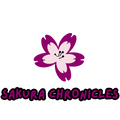















https://sakurachronicles.com/nagoya-unlocked-the-best-places-to-visit-in-the-city